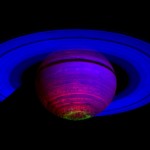Join us this Sunday for a live broadcast from Keck 2 remote observing! Here at Keck we will be participating in a campaign to observe Saturn’s auroras. Join JPL scientist Dr. Kevin Baines and Dr. Tom Stallard of the University of Leicester while they are engaged in using the telescope.

3am-5am Hawai’i Standard Time
6am-8am Pacific Daylight Time
9am-11am Eastern Daylight Time
1pm-3pm UT
You can join the webcast on UStream at the Live from Keck Observatory channel.
A number of telescopes are involved with these observations including NASA’s Hubble Space Telescope and the Cassini spacecraft in orbit around Saturn, the ESO Very Large Telescope (VLT) in Chile, and NASA’s IRTF telescope here on Mauna Kea.
At Keck the team of astronomers have five half night’s of observing on Keck 2 using the NIRSPEC spectrograph. They will be making infrared observations to understand more about the auroral features and the interaction of Saturn’s atmosphere with the planet’s magnetic fields.
